中考常见近义词辨析1
中考语文复习 易混淆的近义词语(包括近义成语)辨析
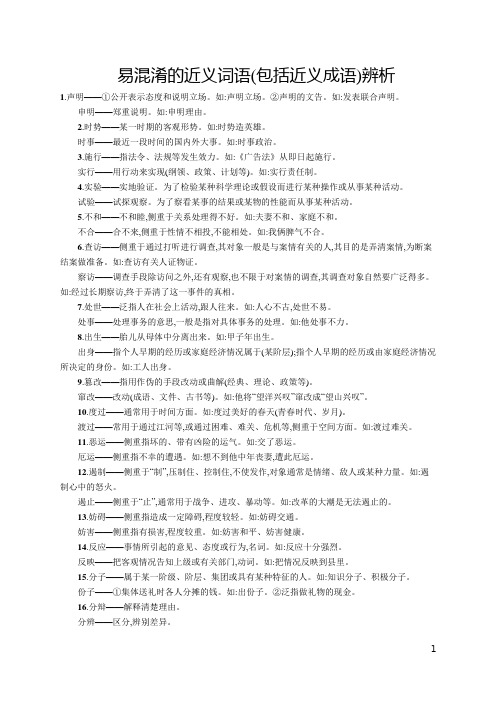
易混淆的近义词语(包括近义成语)辨析1.声明——①公开表示态度和说明立场。
如:声明立场。
②声明的文告。
如:发表联合声明。
申明——郑重说明。
如:申明理由。
2.时势——某一时期的客观形势。
如:时势造英雄。
时事——最近一段时间的国内外大事。
如:时事政治。
3.施行——指法令、法规等发生效力。
如:《广告法》从即日起施行。
实行——用行动来实现(纲领、政策、计划等)。
如:实行责任制。
4.实验——实地验证。
为了检验某种科学理论或假设而进行某种操作或从事某种活动。
试验——试探观察。
为了察看某事的结果或某物的性能而从事某种活动。
5.不和——不和睦,侧重于关系处理得不好。
如:夫妻不和、家庭不和。
不合——合不来,侧重于性情不相投,不能相处。
如:我俩脾气不合。
6.查访——侧重于通过打听进行调查,其对象一般是与案情有关的人,其目的是弄清案情,为断案结案做准备。
如:查访有关人证物证。
察访——调查手段除访问之外,还有观察,也不限于对案情的调查,其调查对象自然要广泛得多。
如:经过长期察访,终于弄清了这一事件的真相。
7.处世——泛指人在社会上活动,跟人往来。
如:人心不古,处世不易。
处事——处理事务的意思,一般是指对具体事务的处理。
如:他处事不力。
8.出生——胎儿从母体中分离出来。
如:甲子年出生。
出身——指个人早期的经历或家庭经济情况属于(某阶层);指个人早期的经历或由家庭经济情况所决定的身份。
如:工人出身。
9.篡改——指用作伪的手段改动或曲解(经典、理论、政策等)。
窜改——改动(成语、文件、古书等)。
如:他将“望洋兴叹”窜改成“望山兴叹”。
10.度过——通常用于时间方面。
如:度过美好的春天(青春时代、岁月)。
渡过——常用于通过江河等,或通过困难、难关、危机等,侧重于空间方面。
如:渡过难关。
11.恶运——侧重指坏的、带有凶险的运气。
如:交了恶运。
厄运——侧重指不幸的遭遇。
如:想不到他中年丧妻,遭此厄运。
12.遏制——侧重于“制”,压制住、控制住,不使发作,对象通常是情绪、敌人或某种力量。
【近义词】中考语文常考词语辨析总结

【近义词】中考语文常考词语辨析总结第一部分1.不齿——不耻:“不齿”指不愿意提到,表示鄙视。
“不耻”意思是“不以……为耻”,“不认为……是可耻的”。
二者表意正好相反。
2.勾通——沟通:“勾通”指暗中串通,相互勾结,贬义词。
而“沟通”指两方能够通连。
3.定金——订金:“定金”指为了保证成交,预先支付的一部分钱。
而“订金”指购买之前约定的价格。
4.预定——预订:“预定”指预先规定或约定。
而“预订”指预先订购。
5.作客——做客:“作客”指离开故乡,寄居在别处。
而“做客”指访问别人,自己当客人。
6.质疑——置疑:“质疑”指提出疑问。
而“置疑”指怀疑,一般用于否定的意义。
7.义气——意气:“义气”指主持公道或忠于兄弟朋友的感情。
而“意气”指志趣、性格、气概,也指偏激的情绪。
8.本义——本意:“本义”指词语的本来意义。
而“本意”指原来的意思或意图。
9.功夫——工夫:“功夫”指①本领、造诣;②同“工夫”。
而“工夫”指①占用的时间;②空闲时间;③指时候。
另外,“功夫”除用于“本领、造诣”之意外,可与“工夫”通用。
10.牟取——谋取:“牟取”指获取名利,贬义词。
而“谋取”指的是设法取得,一般用于褒义。
11.巨变——剧变:“巨变”指的是巨大的变化,而“剧变”指剧烈的变化。
12.法制——法治:“法制”指法律制度,包括法律的制定、执行和遵守,是一种治理社会的制度和方法。
而法治:①先秦法家的政治思想,主张依法治国;②根据法律治理国家。
13.自诩——自许:“自诩”指自夸,贬义词。
而自许指以某种崇高的使命激励自己,褒义词。
14.勉励——勉力:勉励,劝人努力。
而“勉力”指努力去做。
15.处世——处事:“处世”泛指在社会上的活动,人际交往。
而“处事”指处理事务。
第二部分16.形迹——行迹:“形迹”指①举动和神色;②痕迹、迹象;③指礼貌,如“不拘形迹”。
而“行迹”指行动的踪迹。
17.原形——原型:“原形”指原来的形状,本来的真实面目,常含贬义。
初中常见近义词辨析
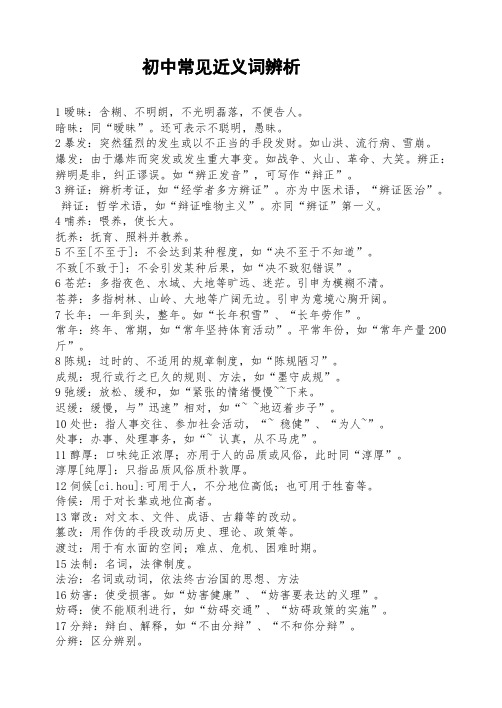
初中常见近义词辨析1暧昧:含糊、不明朗,不光明磊落,不便告人。
暗昧:同“暧昧”。
还可表示不聪明,愚昧。
2暴发:突然猛烈的发生或以不正当的手段发财。
如山洪、流行病、雪崩。
爆发:由于爆炸而突发或发生重大事变。
如战争、火山、革命、大笑。
辨正:辨明是非,纠正谬误。
如“辨正发音”,可写作“辩正”。
3辨证:辨析考证,如“经学者多方辨证”。
亦为中医术语,“辨证医治”。
辩证:哲学术语,如“辩证唯物主义”。
亦同“辨证”第一义。
4哺养:喂养,使长大。
抚养:抚育、照料并教养。
5不至[不至于]:不会达到某种程度,如“决不至于不知道”。
不致[不致于]:不会引发某种后果,如“决不致犯错误”。
6苍茫:多指夜色、水域、大地等旷远、迷茫。
引申为模糊不清。
苍莽:多指树林、山岭、大地等广阔无边。
引申为意境心胸开阔。
7长年:一年到头,整年。
如“长年积雪”、“长年劳作”。
常年:终年、常期,如“常年坚持体育活动”。
平常年份,如“常年产量200斤”。
8陈规:过时的、不适用的规章制度,如“陈规陋习”。
成规:现行或行之已久的规则、方法,如“墨守成规”。
9弛缓:放松、缓和,如“紧张的情绪慢慢~~下来。
迟缓:缓慢,与”迅速”相对,如“~ ~地迈着步子”。
10处世:指人事交往、参加社会活动,“~ 稳健”、“为人~”。
处事:办事、处理事务,如“~ 认真,从不马虎”。
11醇厚:口味纯正浓厚;亦用于人的品质或风俗,此时同“淳厚”。
淳厚[纯厚]:只指品质风俗质朴敦厚。
12伺候[ci.hou]:可用于人,不分地位高低;也可用于牲畜等。
侍候:用于对长辈或地位高者。
13窜改:对文本、文件、成语、古籍等的改动。
篡改:用作伪的手段改动历史、理论、政策等。
渡过:用于有水面的空间;难点、危机、困难时期。
15法制:名词,法律制度。
法治:名词或动词,依法终古治国的思想、方法16妨害:使受损害。
如“妨害健康”、“妨害要表达的义理”。
妨碍:使不能顺利进行,如“妨碍交通”、“妨碍政策的实施”。
中考语文近义词的辨析词汇解释

中考语文近义词的辨析词汇解释中考语文近义词的辨析词汇解释暧昧:含糊、不明朗,不光明磊落,不便告人。
暧昧:同“暧昧”。
还可表示不聪明,愚昧。
爆发:突然猛烈的发生或以不正当的手段发财。
如山洪、流行病、雪崩。
迸发:由于爆炸而突发或发生重大事变。
如战争、火山、革命、大笑。
辨正:辨明是非,纠正谬误。
如“辨正发音”,可写作“辩正”。
辨证:辨析考证,如“经学者多方辨证”。
亦为中医术语,“辨证医治”。
辩证:哲学术语,如“辩证唯物主义”。
亦同“辨证”第一义。
哺育:喂养,使长大。
抚养:抚育、照料并教养。
不至[不至于]:不会达到某种程度,如“决不至于不知道”。
不致[不致于]:不会引发某种后果,如“决不致犯错误”。
苍茫:多指夜色、水域、大地等旷远、迷茫。
引申为模糊不清。
苍茫:多指树林、山岭、大地等广阔无边。
引申为意境心胸开阔。
常年:一年到头,整年。
如“常年积雪”、“常年劳作”。
终年:终年、常期,如“终年坚持体育活动”。
平终年份,如“终年产量200斤”。
陈规:过时的、不适用的规章制度,如“陈规陋习”。
成规:现行或行之已久的规则、方法,如“墨守成规”。
缓和:放松、缓和,如“紧张的情绪慢慢~~下来。
缓慢:缓慢,与”迅速”相对,如“~ ~地迈着步子”。
处世:指人事交往、参与社会活动,“~ 稳健”、“为人~”。
处事:办事、处置事务,如“~ 认真,从不马虎”。
醇厚:口味纯粹浓厚;亦用于人的品质或风俗,此时同“淳朴”。
淳朴[纯厚]:只指品质风俗质朴敦厚。
伺候[ci.hou]:可用于人,不分地位高低;也可用于牲畜等。
侍候:用于对长辈或地位高者。
窜改:对文本、文件、成语、古籍等的'改动。
篡改:用作伪的手段改动历史、理论、政策等。
度过:用于时间方面。
渡过:用于有水面的空间;难点、危机、困难时期。
法制:名词,法律制度。
法治:名词或动词,依法终古治国的思想、方法妨害:使受损害。
如“妨害健康”、“妨害要表达的义理”。
妨碍:使不能顺利进行,如“妨碍交通”、“妨碍政策的实施”。
中考语文常见近义词辨析(第三组)49个

中考语文常见近义词辨析81. 成绩、成就【同】都是并列式的合成词,都有“学习工作中得到的令人高兴的收获”的意思,在句子中主要充当主语、宾语等成分,通用于口语和书面语。
【异】“成绩”多指“一般工作、学习的结果”,语意较轻,属中性词,使用范围较广,不论个人集体、大小好坏都可以使用。
“成就”指“具有创造性、具有社会意义的重大而卓越的成果”,语意比“成绩”重,属褒义词,但使用范围较“成绩”窄,一般用于集体事业,个人对国家或人类有重大贡献也可使用。
另外,“成就”还可作动词,是“完成(多指事业)”之意,主要充当句子的谓语成分。
而“成绩”无此用法。
如:这也怕那也怕是成就不了事业的。
82. 鼓励、鼓舞【同】都是动词,都有“激发人的情绪,使之努力上进”的意思,都是褒义词,在句子中主要充当谓语成分,通用于口语和书面语。
【异】“鼓励”:为并列式的合成词,是“激发、勉励”之意,其方式可以是精神上的,即思想、语言上的激励,也可以是物质上的奖励;适用的对象一般是具体的人或组织,可用于别人对自己,也可用于自己对别人、自己对自己;“鼓励”所带的宾语一般是人或事。
“鼓舞”:是补充式的合成词,有“振作起来,增强信心或勇气”的意思,其方式,仅表现为精神上的激励;适用的对象除具体的人或组织外,还有事件、精神、言行、品德、目标等,主要用于别人对自己;“鼓舞”所带的宾语除了人或事外,还可以是“斗志”“士气”“人心”“决心”等抽象名词。
另外,“鼓舞”可用作形容词,意思是“兴奋、振作”。
如:人们为这大好年景所鼓舞着,谈话中也充满了愉快欢乐的笑声。
83. 技巧、技术【同】都是名词,都“从事某种活动的专门的、有效的经验、方法和能力”的意思,都是褒义词,在句子中主要充当主语、宾语、定语等成分,通用于口语和书面语。
常见的近义词有“技能”、“技艺”、“技法”等。
【异】“技巧”:为陈述式的合成词,着重指“表现在艺术、工艺、体育等方面巧妙的技能”。
技:技能、本领。
中考语文常见近义词辨析49个
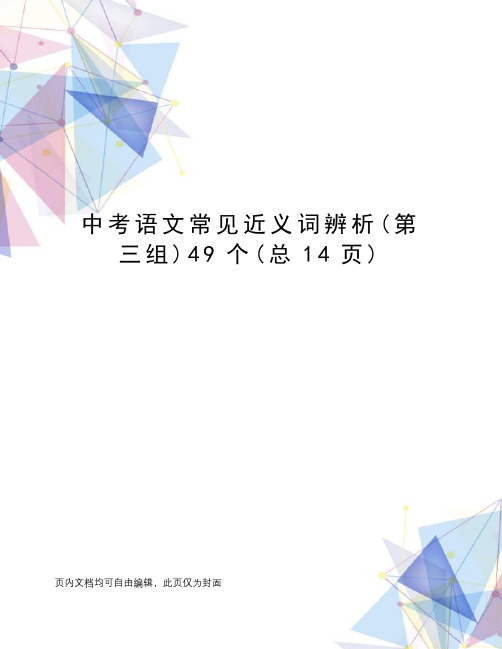
中考语文常见近义词辨析(第三组)49个(总14页)页内文档均可自由编辑,此页仅为封面中考语文常见近义词辨析81. 成绩、成就【同】都是并列式的合成词,都有“学习工作中得到的令人高兴的收获”的意思,在句子中主要充当主语、宾语等成分,通用于口语和书面语。
【异】“成绩”多指“一般工作、学习的结果”,语意较轻,属中性词,使用范围较广,不论个人集体、大小好坏都可以使用。
“成就”指“具有创造性、具有社会意义的重大而卓越的成果”,语意比“成绩”重,属褒义词,但使用范围较“成绩”窄,一般用于集体事业,个人对国家或人类有重大贡献也可使用。
另外,“成就”还可作动词,是“完成(多指事业)”之意,主要充当句子的谓语成分。
而“成绩”无此用法。
如:这也怕那也怕是成就不了事业的。
82. 鼓励、鼓舞【同】都是动词,都有“激发人的情绪,使之努力上进”的意思,都是褒义词,在句子中主要充当谓语成分,通用于口语和书面语。
【异】“鼓励”:为并列式的合成词,是“激发、勉励”之意,其方式可以是精神上的,即思想、语言上的激励,也可以是物质上的奖励;适用的对象一般是具体的人或组织,可用于别人对自己,也可用于自己对别人、自己对自己;“鼓励”所带的宾语一般是人或事。
“鼓舞”:是补充式的合成词,有“振作起来,增强信心或勇气”的意思,其方式,仅表现为精神上的激励;适用的对象除具体的人或组织外,还有事件、精神、言行、品德、目标等,主要用于别人对自己;“鼓舞”所带的宾语除了人或事外,还可以是“斗志”“士气”“人心”“决心”等抽象名词。
另外,“鼓舞”可用作形容词,意思是“兴奋、振作”。
如:人们为这大好年景所鼓舞着,谈话中也充满了愉快欢乐的笑声。
83. 技巧、技术【同】都是名词,都“从事某种活动的专门的、有效的经验、方法和能力”的意思,都是褒义词,在句子中主要充当主语、宾语、定语等成分,通用于口语和书面语。
常见的近义词有“技能”、“技艺”、“技法”等。
【异】“技巧”:为陈述式的合成词,着重指“表现在艺术、工艺、体育等方面巧妙的技能”。
中考近义词辨析概要
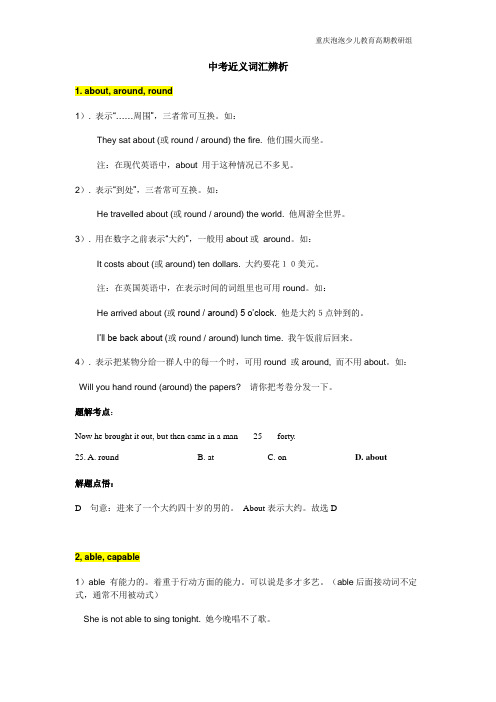
中考近义词汇辨析1. about, around, round1). 表示“……周围”,三者常可互换。
如:They sat about (或round / around) the fire. 他们围火而坐。
注:在现代英语中,about 用于这种情况已不多见。
2). 表示“到处”,三者常可互换。
如:He travelled about (或round / around) the world. 他周游全世界。
3). 用在数字之前表示“大约”,一般用about或around。
如:It costs about (或around) ten dollars. 大约要花10美元。
注:在英国英语中,在表示时间的词组里也可用round。
如:He arrived about (或round / around) 5 o’clock. 他是大约5点钟到的。
I’ll be back about (或round / around) lunch time. 我午饭前后回来。
4). 表示把某物分给一群人中的每一个时,可用round 或around, 而不用about。
如:Will you hand round (around) the papers?请你把考卷分发一下。
题解考点:Now he brought it out, but then came in a man ___25___ forty.25. A. round B. at C. on D. about解题点悟:D 句意:进来了一个大约四十岁的男的。
About表示大约。
故选D2, able, capable1)able 有能力的。
着重于行动方面的能力。
可以说是多才多艺。
(able后面接动词不定式,通常不用被动式)She is not able to sing tonight. 她今晚唱不了歌。
2)capable 有才能的。
语意比able弱。
着重在经过训练而通晓某工作的能力。
中考重点必会词语辨析

中考重点必会词语辨析一、同音词辨析1. 棉(mián)与免(miǎn)【例句】- 这件衣服是纯棉的,质地很好。
- 我们可以免了这一章节的内容,以节省时间。
【辨析】- 棉(mián)指的是一种植物纤维,也可以指代棉花或由棉花制成的物品。
- 免(miǎn)表示不再做某事,避免、不需要或豁免。
2. 嗅(xiù)与休(xiū)【例句】- 狗的嗅觉非常敏锐,能够闻到一般人闻不到的气味。
- 明天是休息日,我们可以休息一整天。
【辨析】- 嗅(xiù)表示闻、闻到、嗅到的动作或能力。
- 休(xiū)表示歇息、休息、放假等意思。
3. 蔬(shū)与书(shū)【例句】- 妈妈强调我们要多吃蔬菜,保持健康。
- 弟弟正在看一本有趣的书,他很喜欢读书。
【辨析】- 蔬(shū)表示蔬菜、蔬果等的意思。
- 书(shū)指的是书籍或书本。
二、形近词辨析1. 发(fā)与法(fǎ)【例句】- 他每天都在练习发音,希望可以准确地说英语。
- 法律是维护社会秩序的重要手段和保障。
【辨析】- 发(fā)表示发出声音,或者特指发音。
- 法(fǎ)指的是法律、法则等。
2. 空(kōng)与孔(kǒng)【例句】- 外面的空气很清新,我喜欢在户外呼吸新鲜的空气。
- 他用一根细棍在纸上敲打出了孔,方便装订文件。
【辨析】- 空(kōng)指的是没有物体存在的状态,或者指代没有被占用的地方。
- 孔(kǒng)表示孔隙、洞口,有形容有洞的意思。
3. 劝(quàn)与圈(quān)【例句】- 爸爸劝我多读书,他说知识可以改变我的人生。
- 妈妈给小狗戴上了一只圈,以防它跑远了。
【辨析】- 劝(quàn)表示劝导、劝说。
- 圈(quān)是一种闭合的形状,也可以指代一种用绳或线等制成的带环装置。
三、近义词辨析1. 容易与简单【例句】- 这个数学题很容易,我很快就能解出来。
- 制作火锅的步骤很简单,只需要准备好材料就可以了。
初中语文:常考近义词辨析汇总

初中语⽂:常考近义词辨析汇总说明:1. 此表按近义词组中相同语素的⾳序编排2. 若⽆相同语素,则按照近义词组中相同的⾳素编排。
3. 若⽆相同⾳素,则按照近义词组中相近的⾳素编排。
A1. 安置/安顿安置:着重指使⼯作、⽣活等有适当的位置。
多是处理⼈事⼯作的活动。
安顿:着重指安排妥当,使有确实的着落。
B1. 包含/包涵包含:包容含有。
包涵:原谅、宽恕。
2. 不齿/不耻不齿:不愿意提到表⽰极端鄙视。
不耻:不顾羞耻不以为有失体⾯;不以为耻。
3. 本义/本意本义:词的本来意义,与引申义、⽐喻义相对。
本意:⼼⾥本来的想法、⽬的。
4. 必须/必需必须:副词,后跟动词,表⽰“⼀定要”。
必需:动词,“⼀定要有”;①可作谓语,如“阵地战也必需”;②多作定语,如“必需的素质”,后跟名词或名词性的短语。
5. 编辑/编撰/编篓编辑:主要指对资料或现成的作品进⾏整理加⼯。
编撰:编纂、编写。
编纂:编写(多指资料、篇幅较⼤的著作)。
6. 变换/变幻变换:指事物的⼀种形式和内容转换成另⼀种。
变幻:后者指不规则的改变(多指抽象、概括性事物)。
7. 辨正/辨证/辩证辨正:辨明是⾮,纠正谬误。
如“辨正发⾳”,可写作“辩正”。
辨证:辨析考证,如“经学者多⽅辨证”。
亦为中医术语,“辨证医治”。
辩证:哲学术语,如“辩证唯物主义”。
亦同“辨证”第⼀义。
8. 申辩/声辩申辩:申诉理由,加以辩解声辩:公开辩解。
9. 个别/各别个别:单个,极少数。
如“个别现象”、“个别处理”。
各别:各不相同,有分别或特别。
如“各别对待”、“形式各别”。
10. 甄别/鉴别甄别:审查辨别;考核鉴别。
鉴别:通过仔细观察加以辨别。
11. 鉴别/辨别鉴别:侧重于从实际上审定真伪与好坏,使⽤范围较⼩,多指具体事物。
辨别:则是根据不同事物的特点,在认识上加以区别,可指具体事物,也可指抽象事物12. 不⼒/不利不⼒:不尽⼒。
如“措施不⼒”。
不利:没好处,不顺利,如“出师不利”。
13. 不⽌/不只不⽌:表⽰数量茫围超出。
中学阶段常考近义词辨析

中学阶段常考近义词辨析心里:胸口内部,头脑里。
心理:内心活动,大脑反映客观现实的过程。
学说:学术上系统的见解、主张。
学术:有系统的、较专门的学问。
威慑:用武力使对方感到恐惧。
威慑力量。
震慑:震动使害怕。
震慑敌人。
启事:向群众说明事件的文字(名词)。
启示:对人加以指点使认识到某些事物(动词)。
充满:布满;充分具有。
充斥:充满(含厌恶意、贬义)。
截止:(到一定期限)停止。
报名在昨天已经截止。
截至:截止到(某个时候)。
报名日期截至本月底止。
附和:(言语、行动)追随别人(多含贬义)。
赞同:赞成,同意(中性词)。
爱戴:敬爱并且拥护。
拥戴:拥护推戴(某人做领袖)。
过渡:事物由一个阶段(状态)逐渐发展变化而转入另一个阶段(状态)。
过度:超过适当的限度。
表率:好榜样。
楷模:榜样、模范(色彩庄重一些)。
原形:原来的形状;本来面目(贬义)。
原形毕露。
原型:文学作品中塑造人物形象所依据的现实生活中的人。
游览:从容行走观看(名胜、风景)。
游历:到远地游览。
逐步:一步一步地,人为能动的安排。
逐渐:渐渐地,强调渐变状态。
权力:政治上的强制力量。
权利:依法行使的权力,享受的利益。
起用:重新任用。
对人而言。
启用:开始使用,对物而言。
法制:法律制度。
法治:以法为准则,治理国家、人民。
必需:一定要有、必不可少。
强调需要。
必须:事理上一定要,不容置疑。
敦促:诚恳地催促。
督促:监督、催促。
标明:做出记号、写出文字使人知道。
表明:表示清楚。
熟悉:知道得清楚。
我熟悉他。
熟习:(对某种技术或学问)学习得很熟练或了解得很深刻。
熟习业务。
鄙弃:看不起、厌恶。
鄙视:轻视,看不起。
考察:实地观察、调查。
考查:用一定的标准来检查、衡量。
局面:一个时期内事情的状态。
局势:指政治、军事等一个时期内发展情况。
时事:最近期间国内外大事。
时势:某一时期客观形势。
期望:希望,期待(只能用于他人)。
希望:心里想着达到某种目的(既可以用于自己,亦可用于他人。
)攀附:投靠有权势的人(贬义)。
2019中考语文常考的近义词辨析:艰苦、艰辛、辛苦
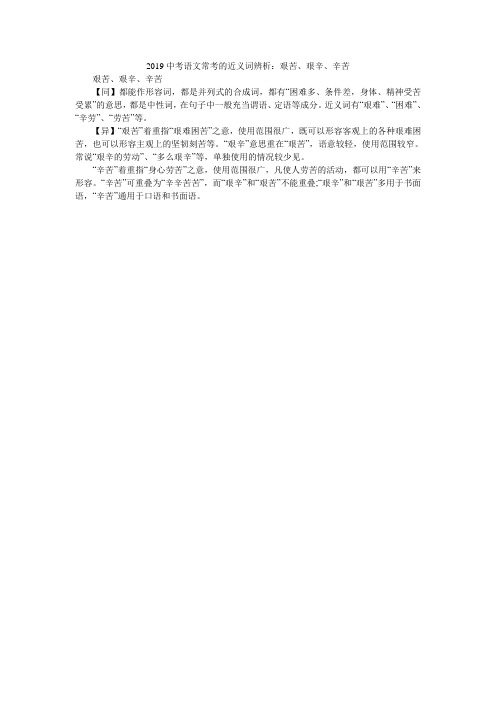
2019中考语文常考的近义词辨析:艰苦、艰辛、辛苦
艰苦、艰辛、辛苦
【同】都能作形容词,都是并列式的合成词,都有“困难多、条件差,身体、精神受苦受累”的意思,都是中性词,在句子中一般充当谓语、定语等成分。
近义词有“艰难”、“困难”、“辛劳”、“劳苦”等。
【异】“艰苦”着重指“艰难困苦”之意,使用范围很广,既可以形容客观上的各种艰难困苦,也可以形容主观上的坚韧刻苦等。
“艰辛”意思重在“艰苦”,语意较轻,使用范围较窄。
常说“艰辛的劳动”、“多么艰辛”等,单独使用的情况较少见。
“辛苦”着重指“身心劳苦”之意,使用范围很广,凡使人劳苦的活动,都可以用“辛苦”来形容。
“辛苦”可重叠为“辛辛苦苦”,而“艰辛”和“艰苦”不能重叠;“艰辛”和“艰苦”多用于书面语,“辛苦”通用于口语和书面语。
初中语文-常见常用近义词辨析(一)

初中语文-常见常用近义词辨析(一)暧昧:含糊、不明朗,不光明磊落,不便告人。
暗昧:同暧昧。
还可表示不聪明,愚昧。
哀号:悲哀的号哭。
哀嚎:悲哀的嚎叫。
如饿狼哀嚎。
爱好:顾惜体面,喜欢打扮。
爱好:喜爱,对某种事物具有浓厚的兴趣。
爱怜:怜爱。
爱恋:热爱而难以分离(多指男女之间)。
安定:生活形势等平静正常,稳定。
生活安定。
安宁:秩序正常,没有骚扰。
边境安宁。
安谧:安宁,安静。
主要指环境气氛。
安静:没有声音,安稳平静。
平静:着重指平稳,没有不安与动荡。
常形容心情、表情、势态等。
清静:着重指不嘈杂、不杂乱。
安顿:安稳。
使人或事物有着落,着重指安排妥当,使有确实的着落。
安放:使物件处于一定的位置,是具体的动作。
安置:使人或事物有着落。
着重指使工作、生活等有适当的位置。
多是处理人事工作的活动。
安排:着重于分清先后、主次、轻重缓急、有条有理地处理人和事。
多指工作上的处理活动。
安全:都指没有事故或危险。
安全:着重指不受威胁。
使用范围广,能用于国家、生产、交通、操作、人身、生命、财产等。
平安:着重指太平无事,使用范围较窄,多用于人身。
按照:同为介词。
介绍行为的根据。
按照:通用于各种语体,不带尊敬色彩。
依照:多用于书面语体,更适用于国家法规、军政文告等,这时是强调依原样照办,不得走样。
遵照:多用于书面语。
带尊敬色彩,表示遵从依照。
懊悔:形容词。
因未满足心愿而悔恨、烦恼。
懊悔:着重指后悔,是心里恨自己不该做错了事或说错了话。
懊恼:着重指烦恼,心里不痛快,是对别人或自己的言行感到烦恼。
懊丧:都是形容词。
形容因做事或环境不利而失意,情绪低落,精神不振。
懊丧:着重指烦恼而丧气,心中郁闷。
沮丧:沮,气色败坏。
着重指受挫折后灰心失望。
颓丧:颓,委靡不振。
着重指情绪低落,意志消沉。
傲慢:都是形容词。
自高自大或自豪自尊之意。
傲慢:着重指态度上轻慢,目中无人。
也可用于褒义,表示自尊而不可侮。
高傲:着重指思想情绪上把自己看得过高。
用于褒义时表示自豪而又高尚。
(校对版)中考语文典型近义词辨析
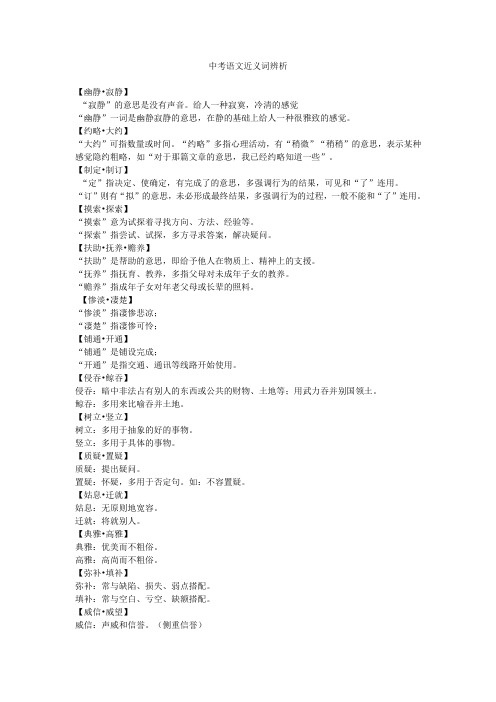
中考语文近义词辨析【幽静•寂静】“寂静”的意思是没有声音。
给人一种寂寞,冷清的感觉“幽静”一词是幽静寂静的意思,在静的基础上给人一种很雅致的感觉。
【约略•大约】“大约”可指数量或时间。
“约略”多指心理活动,有“稍微”“稍稍”的意思,表示某种感觉隐约粗略,如“对于那篇文章的意思,我已经约略知道一些”。
【制定•制订】“定”指决定、使确定,有完成了的意思,多强调行为的结果,可见和“了”连用。
“订”则有“拟”的意思,未必形成最终结果,多强调行为的过程,一般不能和“了”连用。
【摸索•探索】“摸索”意为试探着寻找方向、方法、经验等。
“探索”指尝试、试探,多方寻求答案,解决疑问。
【扶助•抚养•赡养】“扶助”是帮助的意思,即给予他人在物质上、精神上的支援。
“抚养”指抚育、教养,多指父母对未成年子女的教养。
“赡养”指成年子女对年老父母或长辈的照料。
【惨淡•凄楚】“惨淡”指凄惨悲凉;“凄楚”指凄惨可怜;【铺通•开通】“铺通”是铺设完成;“开通”是指交通、通讯等线路开始使用。
【侵吞•鲸吞】侵吞:暗中非法占有别人的东西或公共的财物、土地等;用武力吞并别国领土。
鲸吞:多用来比喻吞并土地。
【树立•竖立】树立:多用于抽象的好的事物。
竖立:多用于具体的事物。
【质疑•置疑】质疑:提出疑问。
置疑:怀疑,多用于否定句。
如:不容置疑。
【姑息•迁就】姑息:无原则地宽容。
迁就:将就别人。
【典雅•高雅】典雅:优美而不粗俗。
高雅:高尚而不粗俗。
【弥补•填补】弥补:常与缺陷、损失、弱点搭配。
填补:常与空白、亏空、缺额搭配。
【威信•威望】威信:声威和信誉。
(侧重信誉)威望:声誉和名望。
(侧重名望)【违反•违拗•违犯】违反:不遵守,不符合(法则、法程)违拗:违背、有意不依从(上级和长辈的主意)违犯:违背和触犯(法规)。
【变化•变幻】变换:事物的一种形式和内容转换成另一种。
变幻:不规则的改变(多指抽象、概括性事物)【调节•调剂】调节:从数量上或程度上调整,使适合要求。
初中语文中考常考“近义词辨析”汇总(共40个)
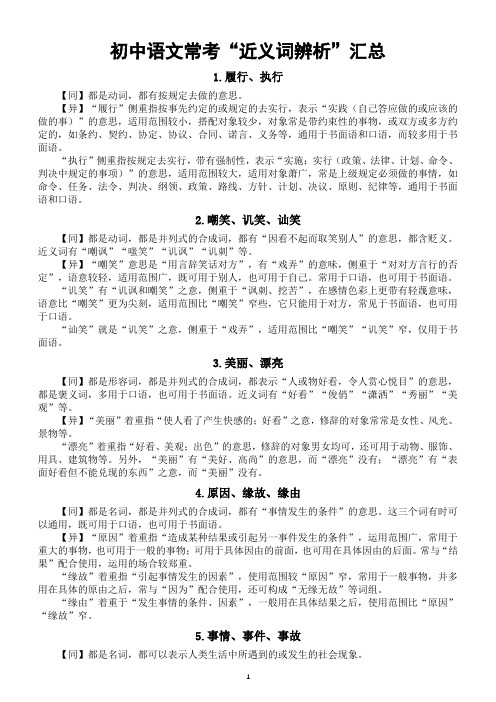
初中语文常考“近义词辨析”汇总1.履行、执行【同】都是动词,都有按规定去做的意思。
【异】“履行”侧重指按事先约定的或规定的去实行,表示“实践(自己答应做的或应该的做的事)”的意思,适用范围较小,搭配对象较少,对象常是带约束性的事物,或双方或多方约定的,如条约、契约、协定、协议、合同、诺言、义务等,通用于书面语和口语,而较多用于书面语。
“执行”侧重指按规定去实行,带有强制性,表示“实施;实行(政策、法律、计划、命令、判决中规定的事项)”的意思,适用范围较大,适用对象萧广,常是上级规定必须做的事情,如命令、任务、法令、判决、纲领、政策、路线、方针、计划、决议、原则、纪律等,通用于书面语和口语。
2.嘲笑、讥笑、讪笑【同】都是动词,都是并列式的合成词,都有“因看不起而取笑别人”的意思,都含贬义。
近义词有“嘲讽”“嗤笑”“讥讽”“讥刺”等。
【异】“嘲笑”意思是“用言辞笑话对方”,有“戏弄”的意味,侧重于“对对方言行的否定”,语意较轻,适用范围广,既可用于别人,也可用于自己。
常用于口语,也可用于书面语。
“讥笑”有“讥讽和嘲笑”之意,侧重于“讽刺、挖苦”,在感情色彩上更带有轻蔑意味,语意比“嘲笑”更为尖刻,适用范围比“嘲笑”窄些,它只能用于对方,常见于书面语,也可用于口语。
“讪笑”就是“讥笑”之意,侧重于“戏弄”,适用范围比“嘲笑”“讥笑”窄,仅用于书面语。
3.美丽、漂亮【同】都是形容词,都是并列式的合成词,都表示“人或物好看,令人赏心悦目”的意思,都是褒义词,多用于口语,也可用于书面语。
近义词有“好看”“俊俏”“潇洒”“秀丽”“美观”等。
【异】“美丽”着重指“使人看了产生快感的;好看”之意,修辞的对象常常是女性、风光、景物等。
“漂亮”着重指“好看、美观;出色”的意思,修辞的对象男女均可,还可用于动物、服饰、用具、建筑物等。
另外,“美丽”有“美好、高尚”的意思,而“漂亮”没有;“漂亮”有“表面好看但不能兑现的东西”之意,而“美丽”没有。
高频常考 近义词辨析

高频常考近义词辨析1.懊悔:侧重在“悔”,有后悔之意。
懊恼:侧重在“恼”,表示烦恼,心里有不痛快之意。
2.铲除:对象是具体事物,也可以是抽象的对象。
根除:对象一般是抽象的,有害的事物。
3.沉湎:强调深深陷入。
沉浸:多比喻人处于某种气氛或思想活动中。
4.传递:侧重点在于递送,主要用于物质形式的东西。
传承:主要用于非物质形式的东西。
5.崇拜:着重指特别钦佩。
程度比“崇敬”重。
崇敬:着重指特别尊敬。
6.微薄:微小单薄;数量少。
一般用于形容数量少。
卑微:低下而渺小。
用于说明某人的出身或地位较低。
7.蕴藏:蓄积而未显露或未发掘。
蕴含:包含。
8.浮躁:侧重于“浮”,表示轻浮而不冷静。
烦躁:侧重于“烦”,表示心情烦乱,烦闷,不舒畅。
急躁:侧重于“急”,表示性情着急,缺乏耐性。
焦躁:表示内心火急火燎。
9.荒凉:人烟稀少,冷清,形容人气状况。
偏僻:不但人气不旺,而且地处偏远,多用于环境。
10.演绎:由一般原理推出关于特殊情况下的结论。
演示:利用实验或实物、图表把事物发展变化过程显示出来,使人有所认识或理解。
11.赋予:使用范围较窄,所给的东西是重大二抽象的,带郑重色彩。
给予:给,使用范围较广。
12.寂静:侧重于“静”,没有一点儿声音,用于环境。
恬静:安静,多形容人的闲适。
13.节制:限制或控制。
扼制:抑制,控制。
语气更强烈,更坚决。
14.敬仰:着重于仰慕,带有明显庄重色彩。
敬佩:着重于佩服,心悦诚服。
15.保障:保护(生命、财产、权利等),使不受侵犯和破坏。
保证:担保做到,确保既定的要求和标准不打折扣。
16.宽广:可以指人心胸开阔,见识广博。
宽敞:指空间大,宽绰,敞亮。
一颗小菜菜:17.领悟:强调悟出、理解、弄名词。
领略:强调体验、欣赏、认识或尝试。
18.摸索:试探着(行进);寻找方向、方法经验等。
探索:多方寻求答案,解决疑问。
19.牟取:谋取(名利)。
多指用不正当手段取得。
谋取:设法取得。
20.凝视:聚精会神地看。
- 1、下载文档前请自行甄别文档内容的完整性,平台不提供额外的编辑、内容补充、找答案等附加服务。
- 2、"仅部分预览"的文档,不可在线预览部分如存在完整性等问题,可反馈申请退款(可完整预览的文档不适用该条件!)。
- 3、如文档侵犯您的权益,请联系客服反馈,我们会尽快为您处理(人工客服工作时间:9:00-18:30)。
1.too much/much too前者表示"太多”,后者为副词短语,后加形容词,意思是“太…”,如much too heavy,太重了。
2.instead/instead of前者后跟句子,强调后面的句子;后者后跟词或短语,强调前面的事物.3.passed/past前者是动词pass的过去式,意为“传递,通过”;后者为介词,前面须加动词构成动介短语,如walk past the garden,意为“从公园旁边经过”4.a number of /the number of前者意思是“许多”,等同于many,修饰可数名词;后者意思是“…的数量”,如The number of the students is 50.A number of students are running.Hundreds of students are running.rmation/news/message前两个为不可数名词,message为可数名词。
Information强调对人或物抽象的描述;news强调新闻或消息,No news is good news:没有消息就是好消息;message强调短信或口信。
7.but/however/whileBut表否定,前后出现反义词;However表转折,前后为同一主语;While强调对比,两者进行对比。
8.for example/such as前者表示举个例子,通常跟句子;such as表示列举,如such as A, B and C.9.alive/living前者只能作后置定语,如a dog alive,一条活着的狗;后者做前置定语,如a living dog,一条活着的狗。
10.cost/spend/take/paySpend 和pay的主语是人;cost和take主语是物,其中通常用it作形式主语。
It takes / took …11.wear/put on/dressWear强调状态;put on强调动作;dress sb.给某人穿衣服。
Dress up:乔装打扮12.job/work前者强调职业;后者强调琐事。
13.how many times/how soon/how often/how longHow many times:多少次,答语为:基数词+timesHow often:提问频率,答语为:Three times a month.How long:答语为for +时间段How soon:答语为in+时间15.across/through两者都为介词,前者强调从表面经过,后者强调从内部穿过。
16.one / itOne指一类中的一个;it特指上文提到的事物。
17.pleasant/pleased/pleasure/pleasePleasant=pleasing,令人高兴的,用来修饰物;pleased用来形容人,高兴的;pleasure通常用于“My pleasure”或“With pleasure”等短语,有“乐意效劳”的意思;please用作动词表示“取悦某人,令某人高兴”。
18.besides/except/except forBesides意思是“除了…,还有…”;except意思是“排除…”;except for表示从整体中排除部分。
如:Everyone goes to the park except Xiaoming.(小明没去公园) Besides Xiaoming, Jack and Rose went to the park, too.(小明去公园了)The movie is very interesting except for the ending.那部电影除了结尾都很有趣。
(结尾也属于电影本身)19.lie/layLie意为“平躺”或“说谎”;lay意为“把……放在……上”或“下蛋”。
20.attend/join/take part inAttend通常指参加比较正式的活动,如婚礼,会议等;join表示加入一个长期的组织;take part in表示参加一个短期的活动。
22.say/speak/talk/tellSay后常跟某人所说的原话;speak后可以跟某种语言或者表示用什么样的语调说话;talk表示讨论,后常跟介词with sb.或about sth;tell意思是告诉,常见搭配为:tell sb. to do sth.23. look at / see / watch / noticeLook at强调看的动作;see强调看到的结果;watch强调长时间的观看,如watch TV, watch a football match; notice意为“察觉到”,后常跟一个状态或结果。
He noticed his yearbook was gone.(2010年北京中考完形)24.above/overAbove强调上方,侧重于斜上方;over表示正上方。
令,其余几组互为反义词的介词为:On---beneath; under---over; above---below25.almost/nearlyAlmost可以用于表示否定意义的句子,而nearly不可以。
26.also/too, neither, as wellAlso通常用于句中;too通常用于句末;neither表示否定的“也”;as well通常跟在形容词之后。
27.among/betweenAmong表示在三者或三者以上的中间;between特指在两者中间。
28.around/near(by)Around表示在四周;near表示在附近。
29.arrive(at/in)/ reach, get toArrive at后跟小地点,如车站,机场等;arrive in后跟大地点,如城市,国家等;reach后直接跟地点;reach sp=get to sp30. ill, sickill只能作表语,sick既可以做表语,又可以作定语。
如:He is ill=he is sick 作表语;He is a sick boy 做定语。
He is a ill boy 表达不正确。
31.below / underBelow表示下方,侧重于斜下方,under强调正下方。
35.game/matchGame指小游戏,match指正式比赛。
37.high/tallHigh通常指建筑物的告诉,tall通常形容人的身高。
38.hope/wishHope意为“希望”;wish意为“祝愿”39.house/homeHouse指句子的房子;home指家庭,有抽象的意义。
41. journey / travel / trip / tourJourney特指通向具体目的地的旅程;travel表示旅程;trip强调旅行途中;tour强调旅行地的所见所闻。
ugh/smileLaughter:笑声Laugh at嘲笑;smile微笑,smile at sb.对某人微笑。
43.loud/noisyLoud指声音大;noisy指噪音。
44.problem/question前者强调解决;后者强调回答。
49.raise/riseRaise money:集资,攒钱;raise sb. 把某人拉扯大;raise flowers养花;raise your hand举手;rise指太阳的升起。
The sun rises in the east and sets in the west.太阳东升西落。
50.hear/listen to/soundHear强调听的结果,意为“听到”;listen to强调听的动作;sound 为感官动词,意为“听起来”,后跟形容词,如The music sounds beautiful.那首曲子听起来很美。
51.little/few/ a little/ a few / smallLittle, a little修饰不可数名词;few, a few修饰可数名词;little, few 表示否定意义;a little, a few表示肯定意义。
A small dog一条小狗(体型)A little dog一条小狗(年龄)52.sound/voice/noiseSound指一切声响;voice特指嗓音;noise指噪音。
55.other/another/the other/others, the othersOther意为“其余的,其他的”,后跟名词,other + n =others; the other 特指两者中的另外一个;the others特指两部分中的另外一部分;another指三者或三者以上的另外一个。
同时还有“有一个,再一个”的意思。
56.good/well前者为形容词,后者为副词。
57.must/have to/mustn't/needn'tMust强调主观意愿;have to强调由于客观条件的限制而“不得不”;mustn’t意为“禁止”,语气很强烈;对于must引导的问句的否定回答要用needn’t。
58.pay/spend/cost/takePay和spend的主语是人,pay常与for连用;cost和take的主语是物,且通常用it作形式主语。
59.keep/borrow / lendBorrow表示借入;lend表示借出;keep表示长时间的借(短期拥有)60.bring/take/carryBring强调带来,靠近说话者;take强调带走,远离说话者;carry 指携带,没有方向性。
